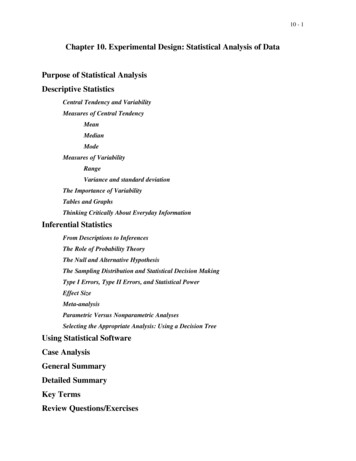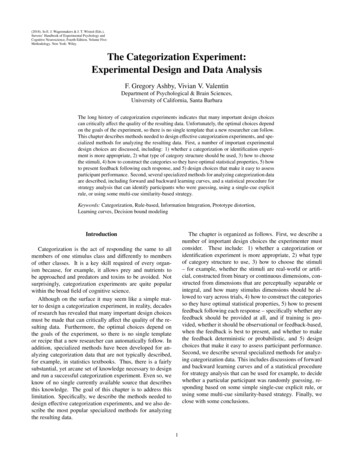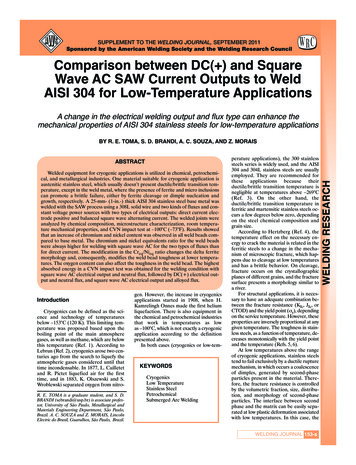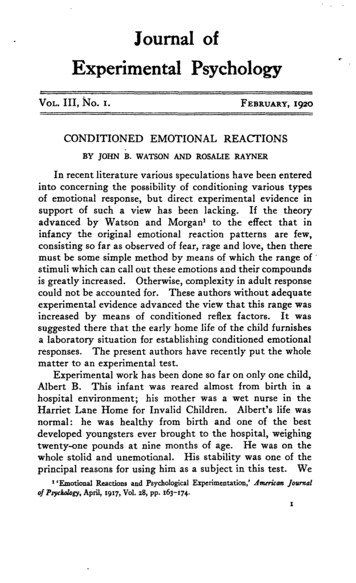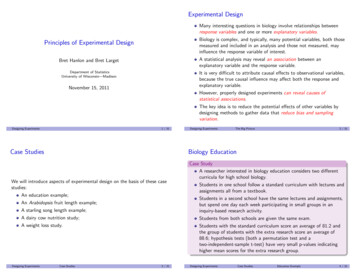
Transcription
Experimental DesignMany interesting questions in biology involve relationships betweenresponse variables and one or more explanatory variables.Biology is complex, and typically, many potential variables, both thosemeasured and included in an analysis and those not measured, mayinfluence the response variable of interest.Principles of Experimental DesignA statistical analysis may reveal an association between anexplanatory variable and the response variable.Bret Hanlon and Bret LargetDepartment of StatisticsUniversity of Wisconsin—MadisonIt is very difficult to attribute causal effects to observational variables,because the true causal influence may affect both the response andexplanatory variable.November 15, 2011However, properly designed experiments can reveal causes ofstatistical associations.The key idea is to reduce the potential effects of other variables bydesigning methods to gather data that reduce bias and samplingvariation.Designing Experiments1 / 31Case StudiesDesigning ExperimentsThe Big Picture2 / 31Biology EducationWe will introduce aspects of experimental design on the basis of these casestudies:An education example;Case StudyA researcher interested in biology education considers two differentcurricula for high school biology.Students in one school follow a standard curriculum with lectures andassignments all from a textbook.A starling song length example;Students in a second school have the same lectures and assignments,but spend one day each week participating in small groups in aninquiry-based research activity.A dairy cow nutrition study;Students from both schools are given the same exam.A weight loss study.Students with the standard curriculum score an average of 81.2 andthe group of students with the extra research score an average of88.6; hypothesis tests (both a permutation test and atwo-independent-sample t-test) have very small p-values indicatinghigher mean scores for the extra research group.An Arabidopsis fruit length example;Designing ExperimentsCase Studies3 / 31Designing ExperimentsCase StudiesEducation Example4 / 31
Arabidopsis ExampleArabidopsis GenotypesCase StudyA researcher conducts an experiment on the plant Arabidopsis thaliana thatexamines fruit length.a gene from a related plant is introduced into the genomes of fourseparate Arabidopsis plants;Case StudyThe gene (call it R) is inserted into one locus for each T1 transgenicplant;The sister chromosome will not have the transgenic insertion;After self-fertilization, we would expect:each of these plants is the progenitor of a transgenetic line.Ian additional Arabidopsis plant is included in the experiment, butdoes not have the trans-gene introduced;Ithese five plants represent the T1 generation;Ieach T1 plant is grown, self-fertilized, and seed is collected;about 25% of the T2 plants to have 0 copies of the transgenic element;— this is genotype SSabout 50% of the T2 plants to have 1 copy of the transgenic element;— this is genotype RSabout 25% of the T2 plants to have 2 copies of the transgenic element;— this is genotype RRa sample of 25 seeds from each plant are potted individually, grown,and self-fertilized;The genotype of each T2 plant is inferred by collecting and growing asample of its seeds.these plants are the T2 generation;All wild type offspring have geneotype SS.the length of a sample of ten fruit is measured for each T2 plant.Designing ExperimentsCase StudiesArabidopsis Example5 / 31TransgeneIndividual 1TransgeneIndividual 2TransgeneIndividual 3Wild typeoffspringTransgene 1Offspringgenotype RSTransgene 1Offspringgenotype SSDesigning ExperimentsTransgene 2Offspringgenotype SSTransgene 1Offspringgenotype RRCase StudiesTransgene 4Offspringgenotype SSMale starlings sing in the fall when they are in flocks of other malebirds.Transgene 4Offspringgenotype RRIt is difficult to categorize a single song as “spring-like” or “fall-like”,but characteristics of song can be different at the two times.Transgene 3Offspringgenotype RSTransgene 3Offspringgenotype SSOne simple song characteristic is the length of the song.In an experiment, a researcher randomly assigned 24 starlings into twogroups of 12.Transgene 3Offspringgenotype RRArabidopsis Example6 / 31Male starlings sing in the spring from a nest area when they attemptboth to attract females as potential mates and to keep other malesaway.Transgene 4Offspringgenotype RSTransgene 2Offspringgenotype RRArabidopsis ExampleCase StudyStarlings are songbirds common in Wisconsin and elsewhere in theUnited States.TransgeneIndividual 4Self-fertilize, grow, plant individual seeds, growTransgene 2Offspringgenotype RSCase StudiesStarling SongArabidopsis ExperimentWildTypeDesigning Experiments7 / 31Designing ExperimentsCase StudiesStarling Song Example8 / 31
Starling Song (cont.)Dairy Cattle Diet ExampleCase StudyAll measurements are taken in animal observation rooms in a researchlaboratory.Case StudyIn a study of dairy cow nutrition, researchers have access to 20 dairycows in a research herd.The spring group was kept in a spring-like environment with morelight, a nest box, and a nearby female starling.Researchers are interested in comparing a standard diet with threeother diets, each with varying amounts of alfalfa and corn.The male group was kept in a fall-like environment with less light, nonest boxes, and in the proximity of other male birds.In the experiment, the cows are randomly assigned to four groups of 5cows each;Each bird was observed and recorded for ten hours: birds sangdifferent numbers of songs, and the length of each song wasdetermined.Each group of cows receives each of the four diet treatments for aperiod of three weeks; no measurements are taken the first week sothe cow can adjust to the new diet.Each bird sang from between 5 and 60 songs.The diets are rotated according to a Latin Square design so that eachgroup has a different diet at the same time.(In the actual study, characteristics of the songs beyond their lengthwere of greater importance.)Designing ExperimentsCase StudiesStarling Song Example9 / 31Latin Square DesignResponse variables include milk yield and abundance of nitrogen inthe manure.Designing ExperimentsCase StudiesDairy Diet Example10 / 31Weight-loss StudyDefinitionA Latin square design is a design in which three explanatory variables(typically one treatment and two blocking), each of which is categoricalwith the same number of levels (in this example, four), so that each pairof variables has the same number of observations for each possible pair oflevels. Treatments are placed in a square so that each row and columncontains each treatment once.Diets are named A, B, C, and D. Each group of cows gets all four diets,but in different orders.Group1234Designing ExperimentsFirstACBDCase StudiesTime PeriodSecond Third FourthBCDADBDACCBADairy Diet ExampleCase StudyResearchers in the Department of Nutrition recruited 60 overweightvolunteers to participate in a weight loss study.Volunteers were randomly divided into two treatment groups.All subjects received educational information about diet.IIone treatment group was instructed to count and record servings ofeach of several food types each day;the other treatment group was instructed to count and record caloriesconsumed each day.Subjects were not aware of the instructions given to members of theother group.11 / 31Designing ExperimentsCase StudiesWeight Loss Study12 / 31
ConfoundingExperimental ArtifactsDefinitionDefinitionA confounding variable is a variable that masks or distorts the relationshipbetween measured variables in a study or experiment. Two variables aresaid to be confounded if their effects on a response variable cannot bedistinguished or separated.Problem1 What are possible confounding variables that may explain thedifferences in test scores in the education example?2What potential confounding factors are researchers trying to avoidwith the Latin square design for the dairy cow nutrition study?3What are potential confounding factors in the weight loss example?Designing ExperimentsKey ConceptsConfounding13 / 31Experimental ArtifactsA experimental artifact is an aspect of the experiment itself that biasesmeasurements.ExampleAn early experiment finds that the heart rate of aquatic birds is higherwhen they are above water than when they are submerged. Researchersattribute this as a physiological response to conserve oxygen. In theexperiment, birds are forcefully submerged to have their heart ratemeasured. A later experiment uses technology that measures heart ratewhen birds voluntarily submerge, and finds no difference in heart ratesbetween submerged and above water groups. This suggests that the stressinduced by forceful submersion rather than submersion itself caused thelowering of heart rate in the birds.Designing ExperimentsKey ConceptsExperimental Artifacts14 / 31Control GroupsDefinitionA control group is a group of individuals that do not receive the treatmentof interest, but otherwise experience similar conditions as other individualsin the experiment or study.Problem1 What potential experimental artifacts might be present for thestarling song experiment?2In designing an experiment to study the natural behavior of livingorganisms, what trade offs are there between gathering data in natureor in a laboratory setting?Designing ExperimentsKey ConceptsExperimental Artifacts15 / 31Problem1 What is the control group in the arabidopsis experiment?2Which comparison between the control group and another group maybe most informative about the effects of the experiment?3Is there a control group in the education example? Discuss.4Is there a control group in the starling song example? Discuss.5Is there a control group in the dairy cow nutrition example? Discuss.Designing ExperimentsKey ConceptsControl Groups16 / 31
RandomizationStratified RandomizationTreatment groups can be partially randomized; for example, if in thedairy cow example it was known that there were 8 cows in their firstmilking and 12 cows not in the first milking, the 8 primiparous cowscould be randomly assigned to two to each group and the 12multiparous cows could be randomly assigned three to each group.DefinitionRandomization is the random assignment of individuals to differenttreatment groups.The purpose of randomization is so that the effects of potentialconfounding variables, whether these variables are known or not, arelikely to be divided fairly evenly across treatment groups.Of course, for any particular variable, the values for individuals ineach sample will not be exactly balanced for each specific assignmentto treatment groups.Designing ExperimentsKey ConceptsRandomization17 / 31This is an example of a stratified random sample.Stratification may be warranted if a variable is known to affect theresponse variable of interest in order to lessen the amount ofconfounding that might be caused by an unlucky completerandomization.The trade-off is that other variables may be more likely to beunbalanced in the assigned treatment groups.Designing ExperimentsRandomization ExamplesBlindingProblemDiscuss the role of randomization in each of these examples:Definition1234When is randomization practical?What are the trade offs?Randomization18 / 31Blinding is meant to protect against experimental artifacts that couldbe caused by knowledge of the subjects (or the researchers doing thestudy who may be subconsciously influenced to expect to seesomething consistent with a hypothesis).How might stratification have been done in each case?Key ConceptsRandomizationAn experiment is blinded if the subjects do not know which treatmentgroup they are in. An experiment is double blind if both the subjects andthe researchers measuring responses are unaware of the treatment groupfor each subject.Education example;Starling example;Dairy cow example;Weight-loss example.Designing ExperimentsKey Concepts19 / 31Designing ExperimentsKey ConceptsBlinding20 / 31
Blinding (cont.)ReplicationDefinitionProblemDiscuss the application (actual or possible) of blinding in each example:1Education example;2Starling example;3Arabidopsis example;4Dairy example;5Weight loss example.Replication is the repetition of each treatment on multiple independentexperimental units.Replication is necessary for statistical inference, because it allows forvariation between treatment groups (the variation of interest) to becompared to variation within groups.Inference for a mean requires the ability to estimate the size of atypical deviation (σ) and the mean (µ). If there was only onereplicate, then we could estimate the mean, but not variation aroundthe mean.Beware of pseudoreplication!Designing ExperimentsKey ConceptsBlinding21 / 31PseudoreplicationDesigning ExperimentsKey ConceptsReplication22 / 31BalanceDefinitionPseudoreplication (see page 97, Interleaf 2) is when individualmeasurements are not independent, but are treated as if they are.DefinitionA design is balanced when each treatment group has the same size.In the bird song example, there are many songs, but the songs are notindependent, as songs from the same bird may be more similar thansongs from different birds.In the dairy cow example, their might be daily measurements, but thesampling unit is the cow.In the Arabidopsis example, there are 1250 different fruits, but theyare not independent as they are grouped according to the T2 plantfrom which they come.In the education example, the “treatment” is applied to the school, sothere is no replication at all, with only one school per treatmentgroup.Designing ExperimentsKey ConceptsReplication23 / 31When population standard deviations are equal, the standard error forthe difference is smallest when both sample sizes are equal. (Whenpopulation standard deviations are not equal, this is not necessarilytrue—with unequal standard deviations, it may be beneficial tosample more individuals from groups with higher variance).Data can be analyzed if sample sizes are balanced or not, but somemethods are more accurate when samples are balanced.In the cow nutrition example, balance is forced because each animalreceives each treatment and is measured during each time period.Designing ExperimentsKey ConceptsBalance24 / 31
BlockingExamplesDefinitionBlocking is placing sampling units into groups that are similar with respectto one or more covariates. Treatments are assigned at random within theblocks.The paired design is an extreme form of blocking where each pair ofmeasurements form a block of size two.Blocking on the basis of one factor assures that the one factor is closeto balanced in each treatment group.If you attempt to block on multiple factors, the number of blocksgrows large and there are insufficient individuals to place into eachblock.Blocking is an attempt to directly control for the effects of a factor.Blocking and randomization are two methods to reduce bias fromconfounding factors, but they are in tension with one another; themore blocking that is employed, the less remaining allocation togroups is relegated to randomization.Designing ExperimentsKey ConceptsBlocking25 / 31Problem1 In the dairy cow example, each cow is measured for each of fourtreatments. Explain how this is related to blocking.2In agricultural and ecological experiments, it is common to selectblocks as regions where conditions are similar, and then split theblocks into smaller plots or subplots which are then placed intotreatment groups.3The Arabidopsis experiment resulted in 1250 fruit lengths. How arethese measurements blocked?4The starling birdsong experiment resulted in hundreds of differentsongs. How are these songs blocked?Designing ExperimentsFactorsInteractionDefinitionDefinitionA factor is a single categorical variable. The possible values of a factor arecalled levels.Some studies involve multiple factors.In the dairy cow study, the factor of interest is diet (with four levels,A, B, C, and D), but there are also two nuisance factors (cow groupand time period) that are not of direct interest, but the effects ofwhich need to be controlled.DefinitionIn a complete factorial design, there are individuals for all treatmentcombinations.Problem1 The Latin square for the cow example is not a complete factorialdesign. Explain why a complete factorial design cannot be used in thissetting.Designing ExperimentsKey ConceptsInteraction27 / 31Key ConceptsBlocking26 / 31Two (or more) explanatory variables have an interaction if the effect onehas on a response variable depends on the value of the other variable (orvariables).It is necessary to make observations at all treatment combinations ofthe corresponding variables to estimate interactions.Interaction plots are useful informal graphical devices for exploringinteractions in data.In an interaction plot with two explanatory factors, the levels of onefactor appear on the x axis, the response is on the y axis, and theother explanatory factor is represented with color or a symbol of theplotted points. Lines often connect the means within each group.The further the lines are from being parallel, the stronger theindication of an important interaction.Designing ExperimentsKey ConceptsInteraction28 / 31
Interaction PlotsInteraction PlotlowThe following plot (data from Example 18-3) shows the response(area of red algae) in an experiment in the intertidal habitat ofcoastal Washington on the basis of two factors.The plot indicates that the herbivore treatment has little effect at midtidal zones, but that excluding herbivores results in larger algal growthat low tidal zones.Formal statistical inferences depend on more than observing the lackof parallelism in the plotted lines.square root of areaExperimental location is either just above the low tidal zone ormidway between the low and high tidal zones, and each location iseither accessible to herbivores or not.40mid 6050 30 20 100 minusplusHerbivore TreatmentDesigning ExperimentsKey ConceptsInteraction29 / 31What you should knowYou should know:how to define and recognize all of the concepts related toexperimental design in these notes;how to identify from a description of an experiment possibleconfounding variables;how to distinguish between experimental and observational variables;how to recognize pseudoreplication;how to interpret interaction plots;when it is appropriate to make causal inferences.Designing ExperimentsSummary31 / 31Designing ExperimentsKey ConceptsInteraction30 / 31
The diets are rotated according to a Latin Square design so that each group has a di erent diet at the same time. Response variables include milk yield and abundance of nitrogen in the manure. Designing Experiments Case Studies Dairy Diet Example 10 / 31 Latin Square Design De nition A Latin square design is


